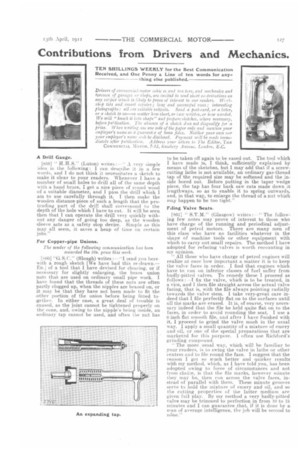Contributions from Drivers and Mechanics.
Page 19

If you've noticed an error in this article please click here to report it so we can fix it.
TEN SHILLINGS WEEKLY for the Best Communication Received, and One Penny a Line of ten words for any thing else published.
Drivers of commercial-motor ethic es and tra:tors, and mechanics and foremen of garages or shops, arc invited to send short co,.trinutions on any subject which is likely to prove of interest to our readers. We,rieslo)fi tips and smart re/airs ; long and successful runs ; interesting photographs : all ,re suitable subjects. Send a post-card, or a letter, or a sketch to us—no matter how short, or low written, or lu:w worded. We will "knock ii into shape" and prepare sketches, where necessary, before publication. The absence of a sketch 'hes not disqualify for a prize. When writing use one side of the paper only and mention your employer's name as a guaranLe of bona fides. Neither your own nor your employer's urt me w it be disclosed, Payment will be made immediately after publication. Address your tellers to The Editor, THE CouNtERCIAL MOTOR, 7-15, Rose/wry Avenue. London, E.C.
A Drill Gauge.
[b59] " H.FI.S." (Luton) writes:— A very simple idea is the following : I can desetibe it in a few worth, and I do not think it necessitates a sketch to make it clear to your readers. Whenever I have a number of small holes to drill all of the same depth with a hand brace, I get a nice piece of round wood -of a suitable diameter, and I pass the drill which 1 am to use carefully through it. I then make the wooden distance-piece of such a length that the protruding part of the drill shall correspond to the depth of the hole which I have to cut. It will be seen then that I can operate the drill very quickly without any danger of going too deep, as the wooden sleeve acts as a safety stop device. Simple as this may all seem, it saves a .heap of time on certain jobs."
_For Copper-pipe Unions..
The sender of the following communication has been awarded the 10s. prize this week.
[t-n(i0] "G.S.C." (Slough) writes :—"I send you herewith a rough sketch [We have had this re-drawn.ED.] of a tool that I have devised for clearing, or if necessary for slightly enlarging, the brass union nuts that are used on ordinary small pipe work. I have found that the threads of these nuts are often partly clogged up, when the nipples are brazed on, or it may be that they have not been made to fit the iother portion of the union before being fitted together. In either case, a great deal of trouble is -caused, as the joint cannot be tightened properly on the cone, and, owing to the nipple's being inside, an .ordinary tap cannot be used, and often the nut has
to be taken off again to be eased out. The tool which I have made is, I think, sufficiently explained by means of the sketches, but I may add that if a screwcutting lathe is not available, an ordinary gas-thread tap of the required size may be softened and the Mside bored out. Before putting in the taper wedge piece, the tap has four hack saw cuts made down it lengthways, so as to enable it to spring outwards, and, in that way, to eniarge the thread of a nut which may happen to be too tight."
Filing Valve Seats.
{Mil " S.T.M." (Glasgow) writes :--" The following few notes may prove of interest to those who have charge of the running and periodical adjustment of petrol motors. There are many men of this class who have no facilities whatever in the shape of machine tools or other equipment with which to carry out small repairs. The method I have adopted for refacing valves is worth recounting in my opinion.
" All those who have charge of petrol engines will realize at once how important a matter it is to keep the valve faces in order. I find that engines which have to run on inferior classes of fuel suffer from badly-pitted valves. To remedy these I proceed as follows :---I fix the valve, which is to be treated, in a vice, and I then file straight across the actual valve facing, that is, with the file always pointing radially towards the valve stem. I take very-great care indeed that I file perfectly flat on to the surfaces until all the marks are erased. It is, of course, very necessary indeed that the file be held quite flat on to the faces, in order to avoid rounding the seat. I use a t3-inch flat smooth file, and after I have finished with it, I proceed to grind the valve much in the usual way. I apply a small quantity of a mixture of emery and oil, or one of the special preparations that are marketed for this purpose. I often use Richford's grinding compound. " The more usual way, which will be familiar to your readers, is to swing the valve in lathe or other centres and to file round the face. I suggest that the reason I get. so much better and quicker results with my method, which, as I have told you, has been adopted owing to force of circumstances and not from choi?,e, is that the file marks, however minute they may be, then run across the valve faces, instead of parallel with them. These minute grooves serve to hold the mixture of emery and oil, and so the cutting properties of the latter medium are given full play. By my method a very badly-pitted valve may be trimmed to perfection in from 10 to 15 minutes and I can guarantee .that, if it is done by a man of average intelligence, the job will be second to mine."




















